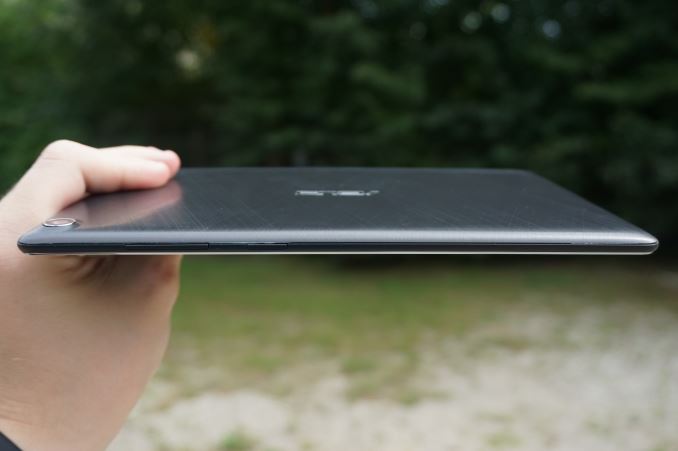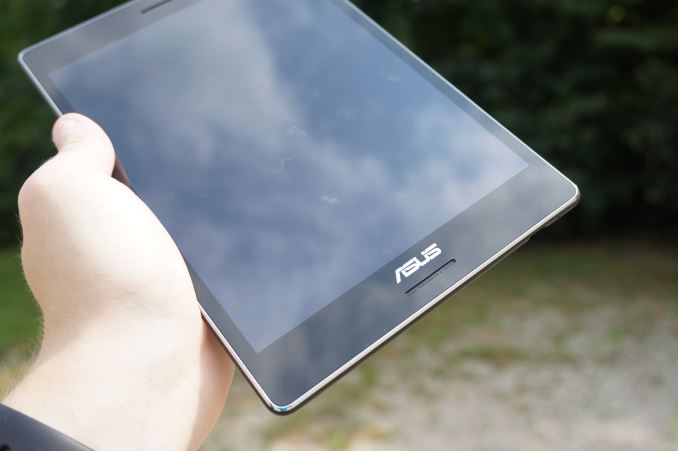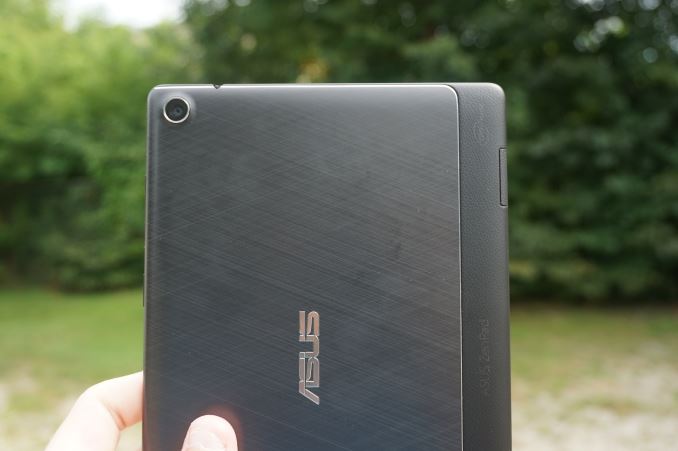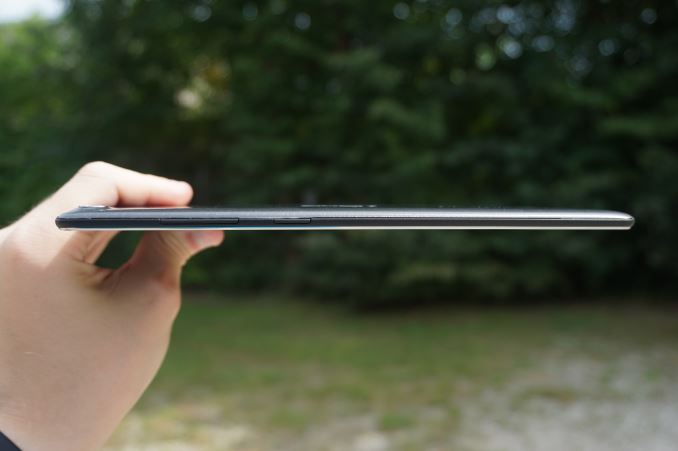The ASUS ZenPad S (Z580CA) Review
by Brandon Chester on August 31, 2015 8:00 AM ESTDesign
In my mind, I think of the ZenPad S Z580CA as a companion to the ZenFone 2. Both devices have an affordable price, and you can really buy both of them and still end up spending less than you would on a flagship smartphone. While they definitely share a UI and many internal hardware components, there isn't much similarity between the external design and construction of the two devices.
The first thing you'll notice when you pick up the ZenPad S isn't how the materials feel, but how incredibly thin and light the entire device feels. It's 6.6mm thick at its thinnest point, and the thickest point is only a small fraction of a millimeter thicker than that. Its mass is only 298g, which makes it the lightest tablet I've looked at to date. While it's not as thin as the iPad Air 2 or the Dell Venue 8 7840, the thickness and mass work together to give a feeling of lightness and portability that I've only ever experienced with one other device, which was the original iPad Mini.
There's not much to say about the front of the ZenPad S. Like all tablets, it's just a big display. ASUS has made space for two front-facing stereo speakers, which is something you won't get on an iPad or on the Galaxy Tab S2. As for the quality of the speakers, my highly subjective evaluation is that they are better than the iPad Air 2, and much better than the Nexus 9. They also don't cause significant chassis vibration despite the tablet's small thickness, which is something the iPad Air 2 suffers from.
Surrounding the edge of the ZenPad's front bezels is a metallic looking silver edge. This is really made of plastic, and like the plastic construction of the ZenFone 2 I'm a bit concerned about its durability. Readers may remember that a single fall from an extremely short height ended up scuffing up the back cover of our ZenFone 2 pretty badly. With the ZenPad S I have made sure to be quite careful, and haven't dropped it or hit it off anything to the best of my knowledge. Even so, there are some small dents in the silver edge. Pressing on it confirms that it's a fairly soft plastic, and I feel like it's going to be a magnet for these types of small dents and marks. In contrast, the Nexus 9 and iPad Air 2 testing units I have could probably be packaged and sold as brand new despite having them in my possession for significantly longer than the ZenPad S. If someone intends to use the ZenPad S as a tablet they can throw into their bag with other objects I would definitely be aware of the potential for damage to the edge.
The back of the ZenPad S is split into two sections. The smaller section has a soft touch feeling, and almost feels a bit like the pleather some phone cases are made of as it has a texture to it. This section is slightly thinner than the rest of the back cover, and it houses the tablet's MicroSD slot. What's interesting is that this part blends smoothly into the sides of the tablet, even though the sides have a distinctly different feeling due to their lack of texture. The soft touch part of the tablet also has the tablet's name and the Intel logo on it. However, it rubs off fairly easily as you can see in the image above, and at the time of writing this paragraph the logos have come off entirely.
The second part of the ZenPad back cover is a large plastic panel. In my review of the ZenFone 2 I said that the back cover of the phone did a good job of mimicking the appearance of aluminum, but felt entirely like plastic. The plastic segment of the ZenPad's back cover could actually convince you that it's made of metal unless you have the urge to tap on it. Like the ZenFone 2, the ZenPad's back cover has a shine to it that looks very much like the reflections made by brushed aluminum, although in the ZenPad's case the back cover has a pattern of overlapping diagonal lines rather than the straight lines of the ZenFone 2. Unfortunately, the hard plastic part of the back cover doesn't give any illusion of the tablet itself being made of metal, as you'll always be touching the soft touch plastic of the sides and the smaller segment of the back.
Right out of the box, my ZenPad S review unit did seem to have some issues with the hard plastic segment of the back cover that I think should have been picked up during QA. As you can see in the images above, there are areas on the edge of the plastic that are warped in such a way that they are no longer smooth like the other sections. It looks like these areas weren't finished properly, and when you look at the tablet from the side you can see that the entire edge around the power button and volume rocker is improperly formed and doesn't have the same color as the rest.
Ultimately I think the ZenPad S does a good job at being what it is, which is a tablet with a plastic chassis. My big concern is that the iPad Mini 2 sits at exactly the same price, and offers a completely aluminum chassis that feels much higher quality and will likely not incur the damage I've seen on the ZenPad's edge and back cover. The iPad is obviously heavier and thicker though, and the only way to achieve the low mass that the ZenPad S has is with plastic.
Personally, I think if I was given the choice I would opt for a slightly thicker and heavier device made of aluminum or a more durable plastic than a thinner and more easily damaged plastic one. The thicker device also has the benefit of storing a larger battery. Other people may value the thinness and the lightness more, particularly with 8" tablets which are more likely to be kept on someone's person than larger tablets. In the end everything is a series of trade-offs, and it's important to think about what aspects of design and build quality matter most to you when considering which tablets to buy.














114 Comments
View All Comments
DanNeely - Tuesday, September 1, 2015 - link
They get enough loaners to keep the review queue in a constant backlog (see periodic comment rage about the review of X, Y, and Z being delayed). If ad revenue ever got to the point that they could hire enough reviewers that they didn't have anything to review at times a shopping trip might make sense; but they don't and probably never will.Even if that did happen, Sony probably wouldn't be the recipient because they've almost entirely abandoned the US market. If you're bound and determined to have one you can get it; but for 99% of the consumers who read the articles and let the ads load (aka the people who actually make the site money) Sony is irrelevant because it's not something they can find in the store.
MrSavage - Tuesday, September 1, 2015 - link
Interesting Dan. Thanks for the insight!Michael REMY - Thursday, September 3, 2015 - link
well, i can believe what i read. you wait for the brand to provide you the device that you review. it is a leak of independence, don't you think ? can't you just buy it on amazon, try it, write your review then get your refund and return the product ?Seriously, for your own knoewledge, you should have test for yourself the last model of sony tablet to win&earn another point of view (better) on samsung tablet or asus zenPad.
IanHagen - Wednesday, September 2, 2015 - link
I'm really glad 4:3 aspect ratio won the battle. It's so much more useful in a tablet.911electronic - Wednesday, September 2, 2015 - link
Nice specification but still i dont know what about battery. It is important for most of the users.DanNeely - Wednesday, September 2, 2015 - link
Page 8 Battery Life and Charge Time. 7 hours on the wifi browsing test is a very poor result.aldenf - Friday, September 4, 2015 - link
Maybe I need to turn in my geek card. I see no benefit whatsoever of such resolutions in an 8" form-factor. The way I use tablets, I prefer the 4:3 ratio. So this is great. I spend far too many hours sitting 30" from my 24" 19x12 IPS, calibrated with a ColorMunki, working in Photoshop and Premiere. With an 8" display, at an 18" distance, I see no benefit above 1280x1024. On the contrary; brightness, performance and battery life suffer significantly. I've used most of what is currently available on the market and don't get the insistence of pushing higher resolutions at 8". I own two 8" tablets; an 800x600 Android and 1024x768 iPad Mini. 800x600 is borderline rough but 1024x768 is pretty good. 1280x1024 seems ideal. Why do we suck up all the marketing baloney? Bigger isn't always better. More isn't always more. It's not the resolution that we discern as better, it's simply that they're usually higher quality displays. Drop the Asus' resolution to 1280x1024, keep the high quality, do a reasonable calibration from the factory, drop the price to $250 and you have a darned nice Android tablet to last a couple of years. Really, what more do we want?nitram_tpr - Wednesday, September 9, 2015 - link
Another vote for widescreen tablets for me, it is all I've ever used (still using a transformer prime). I do watch a lot of medie on my device while I'm travelling / commuting. I tried it on the wife's iPad and got fed up with the huge black bars. Full screening it is like watching an old CRT, so I'm glad there are still the widescreen options out there.To all the people whining and bitching about this tablet, are you actually pissed off because you wanted to buy it, or are you just joining in with the bitch fest?
If it isn't 4:3 don't buy it, end of.
er0k - Monday, September 28, 2015 - link
Hello: My Zenpad 8.0 S is only two days old, out of the box. I cannot seem to charge it. I charged it for many hours yesterday only to find it with a dead battery. I moved it to several different outlets, tried different cables and chargers that work with other devices and worked with it previously, to no avail. It will show the battery charging icon, but does not appear to actually charge. Any ideas? Thanks.System Optimizer - Wednesday, November 4, 2015 - link
er0k,Did you ever get your charging issue solved. Did you try connecting to charge off a computer (if you have USB ports that charge, and the appropriate wire)? Did you hold in the power button and one of the volume buttons to force a reset on the device? (I have an old Archos 80 Titanium tablet, and once I thought it wasn't charging, and was dead, but in reality it was charged and was reporting improper information and the forced reboot resolved the issue). I don't know the z580's reset process, but I expect its something similar.